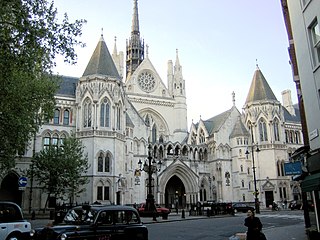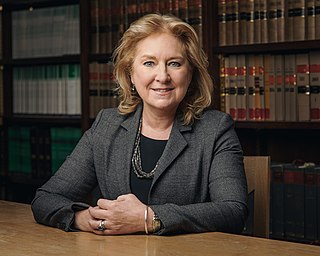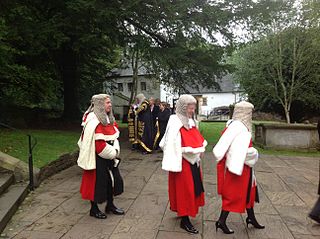
The Court of Appeal is the highest court within the Senior Courts of England and Wales, and second in the legal system of England and Wales only to the Supreme Court of the United Kingdom. The Court of Appeal was created in 1875, and today comprises 39 Lord Justices of Appeal and Lady Justices of Appeal.
The Courts of England and Wales, supported administratively by His Majesty's Courts and Tribunals Service, are the civil and criminal courts responsible for the administration of justice in England and Wales.

The Lady Chief Justice of England and Wales is the head of the Judiciary of England and Wales and the president of the Courts of England and Wales.

Mary Howarth Arden, Baroness Mance,, PC, known professionally as Lady Arden of Heswall, is a former Justice of the Supreme Court of the United Kingdom. Before that, she was a judge of the Court of Appeal of England and Wales.
The courts of Northern Ireland are the civil and criminal courts responsible for the administration of justice in Northern Ireland: they are constituted and governed by the law of Northern Ireland.

A Lord Justice of Appeal or Lady Justice of Appeal is a judge of the Court of Appeal of England and Wales, the court that hears appeals from the High Court of Justice, the Crown Court and other courts and tribunals. A Lord Justice of Appeal is the second highest level of judge in the courts of England and Wales. Despite the title, and unlike the former Lords of Appeal in Ordinary, they are not peers.

There are various levels of judiciary in England and Wales—different types of courts have different styles of judges. They also form a strict hierarchy of importance, in line with the order of the courts in which they sit, so that judges of the Court of Appeal of England and Wales are given more weight than district judges sitting in county courts and magistrates' courts. On 1 April 2020 there were 3,174 judges in post in England and Wales. Some judges with United Kingdom-wide jurisdiction also sit in England and Wales, particularly Justices of the United Kingdom Supreme Court and members of the tribunals judiciary.

A justice of the High Court, commonly known as a High Court judge, is a judge of the High Court of Justice of England and Wales, and represents the third-highest level of judge in the courts of England and Wales. High Court judges are referred to as puisne justices and wear red and black robes.

Dame Victoria Madeleine Sharp,, PC is the President of the King's Bench Division of the High Court of Justice in England and Wales.

The High Court of Justice in London, known properly as His Majesty's High Court of Justice in England, together with the Court of Appeal and the Crown Court, are the Senior Courts of England and Wales. Its name is abbreviated as EWHC for legal citation purposes.

Sir Andrew Ewart McFarlane is a British judge. He was a Lord Justice of Appeal in England and Wales from 2011 to 2018, and became President of the Family Division in July 2018 upon Sir James Munby’s retirement from that office.

Sir Keith John Lindblom, PC, styled The Rt Hon Sir Keith Lindblom, is a King's Counsel and current Lord Justice of Appeal in the Court of Appeal.

David Lloyd Jones, Lord Lloyd-Jones, PC, FLSW is a British judge and legal scholar. He has served as a Justice of the Supreme Court of the United Kingdom since 2017, and has also served as a member of the Court of Appeal of England and Wales and as a chairman of the Law Commission prior to joining the Supreme Court.
The Senior Presiding Judge for England and Wales is a member of the Court of Appeal appointed by the Lord Chief Justice to supervise the Presiding Judges for the various judicial circuits of England and Wales. The Senior Presiding Judge is responsible for deployment and personnel issues for all circuits and acts as a "general point of liaison" for the courts, judiciary and Government.

Sir Timothy Victor Holroyde, PC, styled The Rt. Hon. Lord Justice Holroyde, is an English Court of Appeal judge, formerly a judge of the High Court of Justice of England and Wales, Queen's Bench Division. He was appointed to the Court of Appeal in October 2017. He was sworn of the Privy Council in 2017. In 2015 he was appointed a member of the Sentencing Council for England and Wales, and served as its Chairman between 2018 and 2022. In June 2022 he was appointed Vice-President of the Court of Appeal, succeeding Lord Justice Fulford.

Vivien Judith Rose, Lady Rose of Colmworth, is a British judge currently serving as a justice of the Supreme Court of the United Kingdom.
Sir David Michael Bean is a British judge of the Court of Appeal of England and Wales.

Sir Mark David John Warby PC, styled The Rt Hon. Lord Justice Warby, is a Lord Justice of Appeal.

Dame Kathryn Mary Thirlwall, DBE, styled The Rt Hon Lady Justice Thirlwall, is an English judge of the Court of Appeal, and since December 2019 is the Senior Presiding Judge for England and Wales. She practised as a barrister from 1982, was a High Court judge from April 2010, and was promoted to the Court of Appeal of England and Wales in February 2017.

The King's Bench Division of the High Court of Justice deals with a wide range of common law cases and has supervisory responsibility over certain lower courts.













